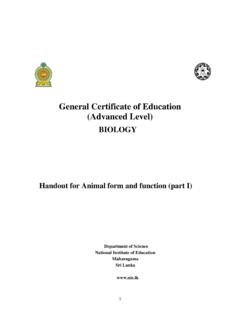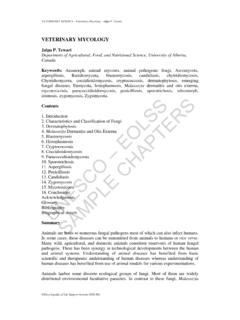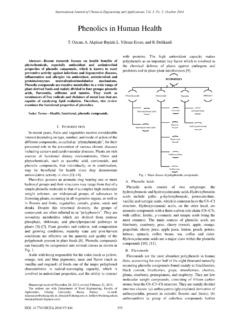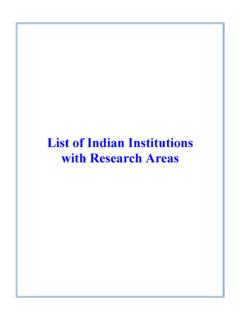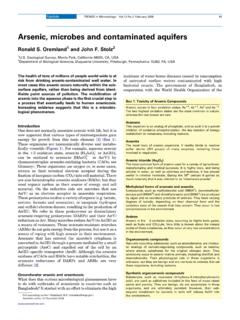Transcription of Unit 1 – Introduction to Biology - nie.lk
1 Unit 1 Introduction to Biology Aims: At the end of the course, students will be able to: develop an interest and desire to expand and deepen knowledge in Biology . understand the concepts, phenomena principles and processes in Biology through collaborative learning practices adjudicate our place in nature, understand our interrelations and impact on the natural and social environment develop the ability to plan investigations, and solve problems in Biology Develop a sense of belonging to the environment and identify the country's natural habitats, together with a positive attitude towards fauna and flora, in order to foster responsibility and involvement in preserving and protecting nature and the quality of the environment.
2 Develop sensitivity to current practical problems of everyday life . Develop an awareness of good habits for maintaining hygiene, health and quality of life . Competency level : Elaborates on the nature, scope and importance of Biology with reference to challenges faced by the mankind Contents: Nature, Scope and importance of Biology Issues pertaining to Biology Understanding biological diversity Understanding the human body and its functions Understanding plant life Management of natural resources and environment Sustainable food production Understanding of diseases and causes Legal and ethical issues Learning outcomes for competency level Students should be able to : describe the nature, scope and importance of Biology , discuss the issues and challenges faced by mankind with reference to Biology , discuss how challenges are overcome using new technologies and appreciate the study of Biology as a multidisciplinary subject.
3 What to teach in two periods ? Nature, scope and importance of Biology : Biology is a branch of science that deals with the study of life . Scientific study of life . (What is life ? The condition that distinguishes animals, plants and microorganisms from inorganic matter. This includes capacity for growth, reproduction, functional activity, and continual change). Biology helps to know about the diversity in the living world, the ways by which it can be conserved, more about ourselves. Biology is a vast field. It includes the study of various aspects of living organisms and their interactions with the non-living components. Biology has three primary branches Botany (the study of plants), Zoology (the study of animals) and Microbiology (the study of microorganisms).
4 Nature, scope and importance of Biology Contd. Some areas of study in these branches: Taxonomy (classification), Morphology (study of external form), Anatomy (study of internal structure), Histology (study of tissues), Cell Biology (Study of cells), Genetics (study of how characters pass to the next generation), Physiology (study of how the animals and plant function) etc. Interdisciplinary branches indicate the relationship of Biology with other branches of science. Some common interdisciplinary branches are Biophysics, Biochemistry, Biometry and Bioinformatics. Psychology and Sociobiology are interdisciplinary branches involving Biology and Social Sciences. Applied branches enable us to apply the knowledge gained from different areas to be used for welfare of man, animals and plants.
5 These include branches like Agriculture, Animal husbandry, Aquaculture, Entomology, Aquaculture, Food technology and Biotechnology. Nature, scope and importance of Biology Contd. Biology is important to everyday life in many ways. It helps to understand how our body is made, how it functions and how it could be maintained in a healthy manner it helps to understand the resources we use and potential threats to those resources it helps to understand our environment we live, threats to our environment and how we could conserve our environment. it helps to understand how life originated on earth and how it has evolved over time. it helps to understand how the characters pass from generation to generation.
6 It helps to improve our health It helps to increase food production Issues pertaining to Biology : Understanding Biological diversity Biological diversity :The variety of life on earth; The number of species of plants, animals, and microorganisms, the diversity of genes in these species, the different ecosystems on the planet, such as deserts, rainforests and coral reefs are all part of a biologically diverse Earth. diversity of these is huge Hence, it is very difficult to understand all of them Number of species on earth: Estimated Number: 10 -100 million Described and catalogued: million Number of genes in humans: 19,000-20,000. Number of ecosystems: An ecosystem includes all of the living things (plants, animals and microorganisms) in a given area, interacting with each other, and also with their non-living environments : How many ?
7 ?? How challenges could be overcome by new technologies?: Molecular Biology , genetic engineering, Issues pertaining to Biology - Contd. Understanding the human body and how it functions Many thing are not known yet. New research is continuously being done; understand what triggers ageing, how cancer originates, how it can be suppressed/controlled, how brain works, the interrelationship between an individual's characteristics (phenotype) and its DNA sequence, - Use of molecular Biology , Nanotechnology, Biophysics, DNA Technology Understanding the plant life Many are not known about plant life too. How plants function? How they synthesize various material in their bodies? How challenges are over come by new technologies?
8 : Use of molecular Biology , Nanotechnology, Biophysics, DNA Technology Issues pertaining to Biology - Contd. Management of natural resources and environment Very important issue Must fill existing gaps in our understanding of the processes that produce biodiversity and contribute to its loss, and to gain a fundamental understanding of how diversity affects productivity, and invasive ability of certain species and anthropogenic impacts How utilization of natural resources could be managed to get the benefits in a sustainable manner How environment could be managed How degraded environments could be restored (Discuss with current information). What are the current environmental issues and how they could be solved/mitigated.
9 Use of Bioinformatics - an interdisciplinary field that develops methods and software tools for understanding biological data. It combines computer science, statistics, mathematics, and engineering to analyze and interpret biological data. Issues pertaining to Biology - Contd. Sustainable food production Human population is ever increasing Environment is getting degraded How these affect food production? How Biology can contribute to increase food production? Improving the quality of the soil by biological methods Using microorganisms - Biotechnology Improving the productivity of plants and animals that are used as food: Breeding techniques, Genetical improvement Genetic engineering, molecular Biology Reducing losses due to pests and diseases or in storage.
10 Sustainability is also important in food production the methods that are used must be useful for many future generations rather than for few seasons. Sustainability includes reducing the carbon footprint of the farming methods also. The amount of carbon dioxide released into the atmosphere as a result of the activities of a particular individual, organization, or community. Use of Biotechnology Give examples; Nanotechnology - nanocapsules containing herbicides; bionanosensors Issues pertaining to Biology - Contd. Understanding diseases and causes Emerging diseases Give some current examples Leishmaniasis - caused by the protozoan Leishmania parasites which are transmitted by sand flies. Dengue Dengue virus Transmitted by Aedis aegyptii and Aedis albopictus.




